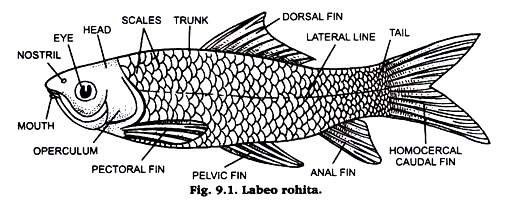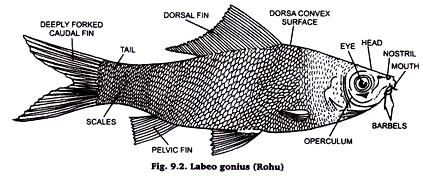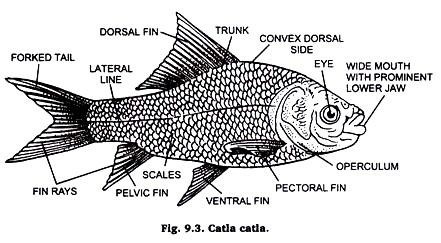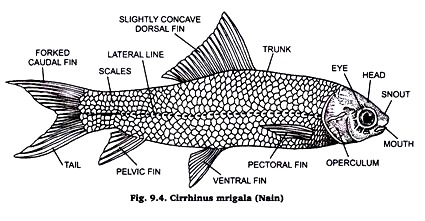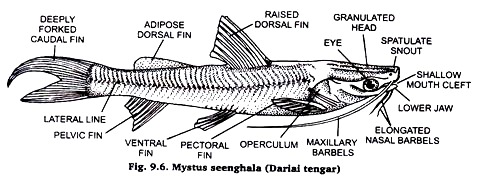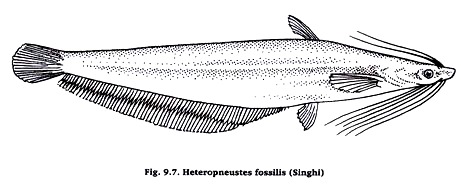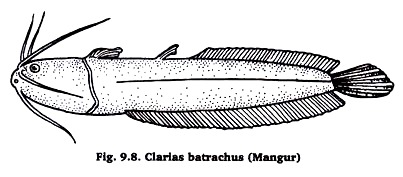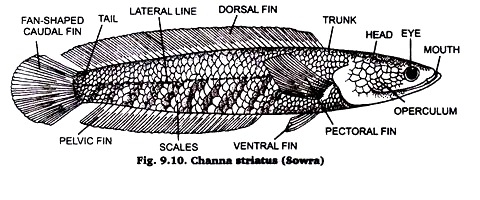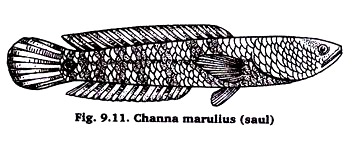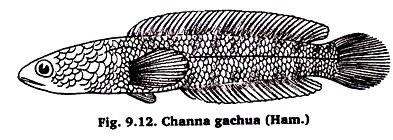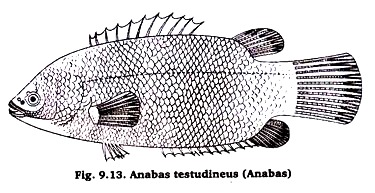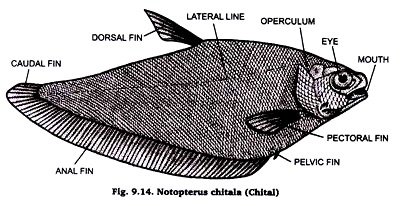The following points highlight the seventeen main types of fresh water edible fishes found in India. The types are: 1. Labeo Rohita 2. Labeo gonius 3. Catla Catla 4. Cirrhinus mrigala 5. Wallago attu 6. Mystus seenghala 7. Heteropneustes fossilis 8. Clarias Batrachus 9. Channa punctatus 10. Channa Striatus 11. Channa marulius 12. Channa gachua 13. Anabas testudineus 14. Notopterus chitala and Others.
Fresh Water Edible Fishes Found in India:
- Labeo Rohita (Rohu)
- Labeo gonius (Rohu)
- Catla Catla (Bhakur)
- Cirrhinus mrigala (Nain)
- Wallago attu (Parhin)
- Mystus seenghala (Dariai Tengra)
- Heteropneustes fossilis (Singhi)
- Clarias Batrachus (Mangur)
- Channa punctatus (Gurrie)
- Channa Striatus (Sowra)
- Channa marulius (saul)
- Channa gachua (Sauri)
- Anabas testudineus (Anabas)
- Notopterus chitala (Chital)
- Mugil cursula (Mullet)
- Mastacembelus armatus (Baam)
- Xenantodon cancila
Type # 1. Labeo Rohita (Rohu):
Classification:
Phylum: Chordata Dorsal tubular nerve cord, notochord and gill-sits.
ADVERTISEMENTS:
Group: Craniata Definite head, cranium and brain.
Subphylum: Vertebrata Vertebrate column present.
Division: Gnathostomata jaws and parried appendages.
Superclass: Pisces Paired fins, gills and skin with scales.
ADVERTISEMENTS:
Class: Osteichthyes Bony fishes.
Subclass: Actinopterygi Ray-finned fishes.
Superorder: Teleostei.
Order: Cypriniformes Anterior vertebrae fused. Weberian ossicles present between air bladder and ear.
ADVERTISEMENTS:
Family: Cyprinidae Air bladder communicates to pharynx.
Type: Labeo Rohita
Distribution:
Labeo rohita is widely distributed in tropical and temperate regions specially found in India (Punjab, Assam) and Burma, Eocene to Recent.
Habit and habitat:
Labeo rohita is abundantly found in ponds and rivers. Carps are vegetarian and bottom feeders. They can occasionally feed on animal diet. Because of its feeding habit, it is cultivated with two other carps, Catla catla and Cirrhina mrigala. Rohu breeds only in the river and bund type of tanks but not in confined waters.
Comments:
1. Labeo rohita is commonly known as carp and Rohu in Hindi.
2. Head is depressed and is produced into a short, obtuse and blunt snout. It bears a sub terminal fringe-lipped mouth bounded by fleshy upper and lower lips. It also contains paired nostrils and paired eyes.
ADVERTISEMENTS:
3. A pair of filamentous barbels arises from upper lip. Small tubercles cover the snout, which is oblong, depressed, swollen and projecting beyond the jaws.
4. Large operculum hangs on either side enclosing gills and branchial chamber.
5. Lateral line is distinct. Scales overlying the lateral line are perforated by tubes of the lateral line system. Scales are of taxonomic value. Scales are flat, bony with rounded edges and are called as cycloid scales. These overlap and form a complete covering.
Economic importance:
Labeo has great food value. Its flesh is rich in proteins & minerals & very delicious. It consists of common man’s food especially in West Bengal it is considered very auspicious. For culture purpose it is very preferable fish. It attains about 1 meter length and weighs about 4 kg within two years.
Type # 2. Labeo gonius (Rohu):
Classification:
Phylum: Chordata
Subphylum: Vertebrata
Superclass: Pisces
Class: Osteichthyes
Order: Cypriniformes
Family: Cyprinidae
Genus: Labeo
Species: Gonius
Distribution:
It is found in India, Pakistan and Burma. In North India it is very common in Orissa, West Bengal, Bihar, Assam, Uttar Pradesh and Punjab.
Habit & habitat:
It inhabits generally in rivers and ponds & very much friendly with culture. It is usually bottom dweller & feeds on submerged vegetation & debris. Breeding takes place in monsoon & in flowing rivers.
Comments:
1. Pigmentation greenish black on the dorsal side, slightly less green laterally while rest of the body silvery white. Black longitudinal bands extend from anterior to the posterior end.
2. Head has eyes, mouth, nostril and is protruded into snout.
3. Mouth is narrow having thick lips and fringeal with an inner fold.
4. Two pairs of minute rostrials and maxillary barbels are present.
5. Dorsal, pectoral, ventral and pelvic fins are of variable size and origin. Caudal fin is deeply forked.
6. Scales small in 12-13 rows between lateral line and base of ventral line.
Identification:
Since the fish contains black bands, minute barbels and above features and it is Labeo gonius.
Economic Importance:
It is very popular food fish & can be caught naturally from the ponds & rivers. Usually it is measuring up to 16 cm in length.
Type # 3. Catla Catla (Bhakur):
Classification:
Phylum: Chordata
Subphylum: Vertebrata
Superclass: Pisces
Class: Osteichthyes
Order: Cypriniformes
Family: Cyprinidae
Genus: Catla
Species: Catla
Distribution:
It is found in Pakistan, India, Bangladesh, Nepal and Myanmar. It has been introduced recently into Sri Lanka & China. Within India, the species is native to North India & now recently introduced in Peninsular India especially in the river Cauvery.
Habitat:
This species mainly inhabits rivers & can be easily cultured in ponds and lakes. The catla is non-predatory and its feeding is restricted to the surface & mid-waters. This characteristic enables this fish to culture with Rohu & main in the same pond. It breeds in rivers during monsoon. In South India, however, the breeding season is variable.
Comments:
1. Pigmentation greyish on dorsal side and silvery on side and abdomen. Fins dark black. Dorsal profile convex.
2. Scales moderate with six and half rows between lateral line and the base of ventral fin.
3. Body divided into head, trunk and tail.
4. Head contains mouth and eyes.
5. Eyes found in the anterior half of the head. Mouth wide with prominent lower jaw.
6. Barbels absent.
7. Dorsal fin slightly more advanced than ventral fin. Pectoral fin located behind ventral fin which does not extend up to the anal fin. Anal fin extending up to the base of caudal fin.
8. Lateral line is complete originating from the upper margin of the gill cover.
Economic importance:
The catla is one of the well-known and fastest growing of the Indian major carps. It is considered an excellent table fish when it is of moderate size. In experimental farms the yield can be as much as ten tonnes per hectare per year.
Type # 4. Cirrhinus mrigala (Nain):
Classification:
Phylum: Chordata
Subphylum: Vertebrata
Superclass: Pisces
Class: Osteichthyes
Order: Cypriniformes
Family: Cyprinidae
Genus: Cirrhinus
Species: mrigala
Distribution:
It is found in Pakistan, Bangladesh, Myanmar and India. In Northern India its natural habitat is in the stretch from the Punjab to West Bengal and Assam. It is widely distributed in India due to its introduction all over the country for fishery purposes.
Habit & habitat:
It usually prefers to inhabit rivers and tanks. In thrives best at altitudes less than 600 m and in places where the minimum water temperature does not drop below 14°C. It has been widely introduced into reservoirs and river systems and it can tolerate high levels of salinity. Breeding usually takes place during the monsoon in the shallow margins of rivers, tanks and also in canals.
Comments:
1. Commonly called as Nain.
2. Fish measures 16 to 26 cm in length.
3. Colouration silvery dark grey on dorsal side and whitish on abdomen.
4. Golden coloured eyes located in anterior half of the head in inter orbital width.
5. Various fins are dorsal, ventral, pectoral, pelvic and caudal. Dorsal fin slightly concave.
6. Pectoral fin contains 18 rays.
7. Caudal fin deeply forked.
Economic importance:
Owing to its large size Mrigal is popular as a food fish & hence has been introduced all over India. One of the main centres of breeding & hybridization of the species is the Central Inland Fisheries Research Institute, Barrack pore. Its trade name is “Red tailed Grass Carp”.
Type # 5. Wallago attu (Parhin):
Classification:
Phylum: Chordata
Subphylum: Vertebrata
Superclass: Pisces
Class: Teleostomi
Order: Cypriniformes
Family: Siluridae
Genus: Wallago
Species: attu
Distribution:
The killer shark is found in fresh water bodies in India, Pakistan, Ceylon, Burma to Java, Sumatra, Siam and Indo-China.
Habit & habitat:
It is usually found in rivers, including tidal lakes, reservoirs, tanks and channels, it prefers deep, still or slow flowing water with a mud or silt substrate. The adult fish is predatory, aggressive and voracious feeder, preying on other fishes.
It stays at the bottom of water in search of food. It is known to inflict painful bites when handled and it does not allow other species to survive under cultured conditions. Breeding occurs in the summer mounts before monsoon. In South India, the breeding occurs with rains.
Comments:
1. This is one of the largest fresh water cat fishes & attains usual length of 61-91 cm.
2. They are provided with large mouth & sharp teeth helpful for predatory action.
3. Lower jaw is slightly longer than the upper jaw.
4. Barbels are of two pairs.
5. Anal fin is long & not confluent with the caudal fin.
6. Caudal fin is deeply forked with longer upper lobe.
Economic importance:
This species is good for eating and also a game fish. This is one of large naturally harvested fish.
Type # 6. Mystus seenghala (Dariai Tengra):
Classification:
Phylum: Chordata
Subphylum: Vertebrata
Superclass: Pisces
Class: Teleostomi
Order: Cypriniformes
Family: Bagridae
Genus: Mystus
Species: Seentghala
Distribution:
The giant river catfish is found in Afghanistan, Pakistan, India, Nepal & Bangladesh. It is distributed throughout India. It South India it extends to river Krishna only.
Habit & habitat:
It prefers large rivers, reservoirs, canals, flooded fields and ponds. Mystus is a predatory fish, feeds on other fishes. It is considered to a graceful swimmer for its size. It is fond of dead flesh which enables it to be a good sports fish. Breeding occurs before the onset of the monsoons, in the months of April & May in South India and in March in the North (Ganga),
Comments:
1. Commonly called as Dariai Tenager.
2. Colouration varies according to habitat. Generally brownish colour along the back and silvery white along the sides and beneath.
3. Barbels four fins namely maxillary barbels, nasal barbels, mandibular barbels and internal mandibular barbels.
4. Teeth on the palate in the form of continuous crescent.
5. Dorsal fin with weak dorsal spine, pectoral fin denticulated, ventral fin near anus and caudal fin deeply forked.
6. A rounded black spot present on the base of adipose fin.
Economic importance:
It is one of the largest edible fishes. It grows to a maximum length of 150 cm & usually up to 40 cm. It is considered to be a very important food fish & fetches a good price in the market.
Type # 7. Heteropneustes fossilis (Singhi):
Classification:
Phylum: Chordata
Subphylum: Vertebrata
Superclass: Pisces
Class: Teleostomi
Order: Cypriniformes
Family: Heteropneustidae
Genus: Heteropneustes
Species: fossilis
Distribution:
It occurs in Pakistan, India, Bangladesh, Nepal, Myanmar, Sri Lanka, Thailand and Laos. It is found throughout in India.
Habit & habitat:
It is found preferably in rivers, estuaries, lakes, ponds flood waters and ditches. It can tolerate even turbid and muddy water due to its ability to breathe air directly. It is able to survive in waters with temperature as high as 39.8°C. Usually they move in shoals close to bottom but when alone stay in services & debris, hidden in mud. When caught, they become active & inflict the most painful sting from their pectoral fins.
Comments:
I. It attains usually the length of 17-23 cm.
II. Barbels are of four pairs.
III. Anal find is long but separated with caudal fin by a distinct notch.
IV. The pectoral spine is capable of inflicting wounds.
V. They are predatory in nature, but not piscivorous.
Economic importance:
It is very popular as a food fish and for its supposed medicinal properties. The flesh of this catfish is also considered to be stimulant. It is very popular in Calcutta where large quantities are caught especially when other species are scarce. The juveniles are kept as aquarium fish. Its trade name is stinging fish.
Type # 8. Clarias Batrachus (Mangur):
Classification:
Phylum: Chordata
Subphylum: Vertebrata
Superclass: Pisces
Class: Teleostomi
Order: Cypriniformes
Family: Claridae
Genus: Clarias
Species: Batrachus
Distribution:
It is distributed through Pakistan, India, Nepal, Sri Lanka, Bangladesh, Myanmar, Indonesia, Kalimantan and the Philippines. It is widespread within India, both naturally and due to culturing. Its occurrence in South India is largely due to culturing.
Habit & habitat:
It is usually found in streams including tidal ponds, channels and flooded rice fields. Due to its ability to breathe in air directly, it can live in muddy water. It is found in hills also. They are voracious feedes & mostly stay buried in the muddy bottom. They are quite aggressive &inflict stings by their pectoral fins. Breeding occurs during the months of July to August in flooded rice fields. It attains maturity at the end of one year.
Comments:
1. The body is elongated with laterally compressed head.
2. Body colour is either uniformly reddish-brown or greyish black.
3. It may attain a maximum length of 45 cm.
4. Upper jaw is longer than the lower.
5. Head is sharpened superiorly and is covered with fin granules.
6. Barbles are of four pairs.
7. Dorsal fin is very long commences a little behind the occipital process and ends a bit anterior to the base of the caudal fin.
8. All the fins are covered with thick skin.
Economic importance:
It is very popular food fish and very economic in culture. Hence it is cultured extensively throughout India. The maximum yield can be obtained in experimental farms up to 50 tons. It fetches a good price. It is used as a laboratory animal for biological studies.
Type # 9. Channa punctatus (Gurrie):
Classification:
Phylum: Chordata
Subphylum: Vertebrata
Superclass: Pisces
Class: Teleostomi
Order: Ophiocephaliformes
Family: Ophiocephalidae
Genus: Channa
Species: punctatus
Distribution:
It is found in Afghanistan, Pakistan, India, Nepal, Sri Lanka, Bangladesh and Myanmar up to China. It is widespread in India occurring largely in the plains.
Habit and habitat:
It lives in ponds, ditches and lakes. It also inhabits rivers & estuaries. It is predaceous & feeds mainly on insects & other microorganisms and small fishes. They can stay out of water for long periods of time. They are also capable of leaping high and jumps out of the water when confined. The spotted snakehead breeds throughout the year. The adults attain a maximum length of 30 cm.
Comments:
1. Dorsally its body is mostly black or dark grey, becoming light grey on the abdomen.
2. Several bands pass from the dorsum of the body downwards to the middle of body, a some cases these markings appear as irregular spots.
3. Dorsal and anal fins extend up to tail fin.
4. Fins are spotted.
5. Lateral line usually straight with a slight curve over the fourth anal ray.
Economic importance:
This fish is poor man’s popular food. The larger individuals are collected as food during the summer when ponds & lakes dry up. It is one of commonly available live fish & is priced a good amount.
Type # 10. Channa Striatus (Sowra):
Classification:
Phylum: Chordata
Subphylum: Vertebrata
Superclass: Pisces
Class: Teleostomi
Order: Ophiocephaliformes
Family: Ophiocephalidae
Genus: Channa
Species: Striatus
Distribution:
It occurs in Pakistan, India, Nepal, Bangladesh, Myanmar up to China and Sri Lanka. In India it is found throughout the country. In South India also it is wide spread.
Habit & habitat:
It prefers to live in stagnant waters i. e., tanks, lakes and large ditches. It is also found in rivers. It favours deep and still waters. This striped snakehead fish is solitary and aggressive by nature. This is predatory and feeds on other fishes. They breed during the rains. The nesting pairs are known to attack humans when encountered.
Comments:
1. Fish measures 17-19 cm in length.
2. Colour of the fish varies in different regions. Dark grey or black colour on dorsal side, under surface yellowish and grey or black transverse bands on sides.
3. Body divisible into head, trunk and tail. Head contains rounded eyes, jaws and mouth.
4. Body scales of irregular shape.
5. Lateral ray curves down after 12th dorsal ray.
6. Dorsal and anal fins reaching up to fan like caudal fin. Pectoral and pelvic fins well developed.
Economic importance:
This is the most popular of the snakeheads as a food fish due to its fine flesh. It is popular as a sport fish also. It is widely cultured in India especially in South India. The adults grow up to a maximum length 75 cm.
Type # 11. Channa marulius (saul):
Classification:
Phylum: Chordata
Subphylum: Vertebrata
Superclass: Pisces
Class: Teleostomi
Order: Ophiocephaliformes
Family: Ophiocephalidae
Genus: Channa
Species: marulius
Distribution:
It is distributed over Pakistan, India, Sri Lanka, Nepal,Bangladesh & Myanmar through Southeast Asia up to China. It is widespread in India, occurring in almost all the states.
Habit & habitat:
It lives in large lakes and rivers, preferring deep water with rocky or sandy bottom. This giant snakehead is known to be territorial and aggressive. They are predatory in nature, feeding on the fishes, water birds, snakes and rodents. It breeds from April till June in specially built, floating nests of weeds & leaves.
Comments:
1. They may attain a length up to 122 cm but are usually of 46 cm.
2. Pectoral fin and anal fins are long but not confluent with candal fin.
3. The colour of body varies with age & locality.
4. Juneniles (measuring 10 to 12 cm) with a brilliant orange band passing from the tip of snout over the eyes to the tip of the caudal fin.
5. Adults bear 4 to 5 round black blotches located below the lateral line in between the pectoral fin & base of the caudal fin.
6. A black ocellus with orasnge boundary is found at the upper part of the base of caudal fin.
Economic importance:
It is popular as a food dish due to its very tasty and boneless flesh. It is considered an excellent sport fish. When it is small, it can be kept in aquaria, although not with smaller fishes.
Type # 12. Channa gachua (Sauri):
Classification:
Phylum: Chordata
Subphylum: Vertebrata
Superclass: Pisces
Class: Teleostomi
Order: Ophiocephaliformes
Family: Ophiocephalidae
Genus: Channa
Species: gachua
Distribution:
It is widely distributed in freshwater bodies of India, Pakistan, Ceylon, Burma and the Andaman’s.
Habit & habitat:
It is usually found in ponds, lakes, ditches & shallow banks of rivers & marshes. It is also very active & aggressive like other snakehead fishes, it feeds on aquatic insects, shrimps and small fishes. Breeding occurs during rainy season.
Comments:
1. Body colour varies according to the habitat.
2. Pectoral fin with a deep blue base, with orange & blue strips, the margin being orange coloured.
3. Scales on the head are broad and irregular.
4. Lateral line curves downwards after 12th scale.
Economic importance:
Economically it is considered good poor man’s food. It is sold as aquaria fish.
Type # 13. Anabas testudineus (Anabas):
Classification:
Phylum: Chordata
Subphylum: Vertebrata
Superclass: Pisces
Class: Teleostomi
Order: Perciformes
Family: Anabantidae
Genus: Anabas
Species: Testudineus
Distribution:
They are found in Pakistan, India, Sri Lanka, Bangladesh and all the way southeast up to the Philippines. In India it occurs throughout the country, especially in the plains.
Habit & habitat:
It normally prefers tanks ponds, ditches, estuaries and swamps. They are associated mainly with turbid and stagnant waters overgrown with aquatic plants. The adults are solitary and aggressive. This species is capable of breathing air directly and can thus survive for many hours outside water.
Using the spines on the gill cover the adults can climb up cervices and even into hollow tree-trunks that are found close to the water, thus earning the title “Climbing Perch”. It feeds mostly on insects. Breeding occurs on the onset of monsoon.
Comments:
1. Climbing perches grow up to a maximum length of 25 cm. but they are normally much smaller.
2. The body is very firm with large hard scales that are easily felt while handling the fish.
3. A black spot at the posterior end of the opercle and another black blotch on the side of the base of the tail are present.
4. Lateral line is interrupted at 18th scale, the 19th scale is a perforated one and is found just below the 10th one.
Economic importance:
Moderate sized fish is very popular as a food fish. Small fish have a great value for Aquarists as they are very fancy and hardy fish. They are sold as live fish.
Type # 14. Notopterus chitala (Chital):
Classification:
Phylum: Chordata
Subphylum: Vertebrata
Superclass: Pisces
Class: Teleostomi
Order: Clupiformes
Family: Notopteridae
Genus: Notopterus
Species: chitala
Distribution:
It is widely spread in fresh water bodies of India, Pakistan, Burma, Siam Malaya, Archipelago, Philippines. In India, it is very much abundant in U.P., Punjab, Bihar, Orissa & other states of North India. In Uttar Pradesh it is declared as state fish for promotion of fish & fishery.
Habit & habitat:
Notopterus commonly inhabits marshy meadows, lakes, freshwater or brackish water. In rivers it is found in Ganges, Brahmaputra & Mahanadi. It is bottom feeder, carnivorous, predaceous and feeding on small organisms, insects and crustaceans.
Comments:
1. Notoptenus is commonly known as cat-fish or chital.
2. Body is very strongly compressed with a short pre-caudal region, measuring about 1.5 meter in length.
3. Colour is silvery dark or greenish or glossy yellow on the back.
4. Head contains large and oblique mouth, whitish-eyes and nostrils. The musciferous channels are well developed on the head.
5. Dorsal fin is short and ventral fin very much reduced or absent. Very much elongated anal fin confluent with reduced caudal fin. Number of combined rays of anal and caudal fin varies from 85-100. Pelvic fin has 3-6, sub-opercular absent.
6. Air bladder is very large and is divided into several compartments.
7. Teeth are homodont.
8. Gill covers are scaly. Lateral line scales 120-180, ventral scutes 25-45.
Economic importance:
This fish has high grade of food value as the flesh is very rich in nutrition and well flavoured. It is a very selective food fish & fetches good price in the market. It has a great scope of cultivation if the fish seed is available.
Type # 15. Mugil cursula (Mullet):
Classification:
Phylum: Chordata
Subphylum: Vertebrata
Superclass: Pisces
Class: Teleostomi
Order: Mugiliformes
Family: Mugilidae
Genus: Mugil
Species: corsula
Distribution:
It is distributed in fresh & esturine waters of Uttar Pradesh, Bihar & Bengal in India and in other countries e.g., Burma & Bangladesh.
Habit & habitat:
It is commonly found in ponds, rivers & is usually called as grey mullet. It swims on the surface in shallow winters keeping the eyes above the surface. The eye sight is very sharp. They prefer to feed on mud, algae and sand but young ones are voracious feeders and feed on planktonic crustacean eggs etc. They can make good long jump and die rapidly. Breeding occurs with the onset of monsoons.
Comments:
1. The maximum length is 46 cm but usually it attains the length of 31 cm.
2. Upper jaw overhung by the suout is longer than the lower. Upper lip thick and notched for receiving the tubercle of the lower lip when the mouth is shut.
3. Scales are fine & small.
4. Lateral line is straight & runs
Economic importance:
The flesh of this fish is known to be an excellent food. It has good demand in the market as a food fish.
Type # 16. Mastacembelus armatus (Baam):
Classification:
Phylum: Chordata
Subphylum: Vertebrata
Superclass: Pisces
Class: Teleostomi
Order: Symabranchiformes
Family: Mastacembelidae
Genus: Mastacembelus
Species: armatus
Distribution:
It is distributed over Pakistan, India, Nepal, Sri Lanka and Bangladesh through Southeast Asia up to China. It is found throughout India like the states of U.P., Assam, Bihar, West Bengal, Punjab, Orissa, Andhra Pradesh, Tamil Nadu, Kerala etc.
Habit & habitat:
It dwells in rivers, including tidal ones, both in the hills and plains. It prefers water bodies with sand, boulder or pebble substrate. It swims in the mid waters. The adults tend to hide within cavities or burrow into the bottom while at rest. They feed along the bottom and sides on detritus but are fond of live food especially worms buried in the bottom. Little is known about its breeding habits.
Comments:
1. Maximum length, the fish can attain is 61 cm.
2. Scales are minute with 30 rows between the lateral line and the base of the first dorsal ray.
3. Dorsal and anal fins are confluent with anal fin, the caudal fin is rounded.
4. There is a row of rounded black spots along the base of the dorsal fin.
Economic importance:
It is very popular as a food fish throughout India. It is also exported small number as an aquarium species.
Type # 17. Xenantodon cancila:
Classification:
Phylum: Chordata
Subphylum: Vertebrata
Superclass:Pisces
Class:Teleostomi
Order: Beloniformes
Family: Beloneidae
Genus: Xenantadon
Species: Camcila
Distribution:
It is found in the Persian Gulf, Pakistan, India, Sri Lanka, Myanmar, Thailand and China. It is widespread in India especially in the Ganges, the Chilika lake and Kerala.
Habit & habitat:
It prefers to live in estuaries, tidal rivers and fresh water streams. The adults swim close to the surface shores, When disturbed the group scatters rather erratically and comes together after a little while in another spot. They keep the front half of the body straight while moving wagging only the rear. Breeding occurs twice in the year in the Chilika lake.
Comments:
1. It attains a length of 21-24 cm.
2. Both the jaws are elongated into a beak which may be longer than the head, lower jaw is slightly longer.
3. A deep longitudinal groove runs along the upper surface of the head.
4. Scales are small & irregularly arranged.
5. Dorsal fin commences opposite the anal.
6. The entire upper 2/3 of the body is marked with closely set fin black dots.
Economic importance:
It has less food value but good as a game fish.
